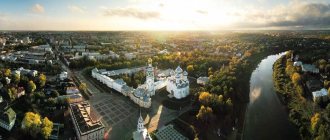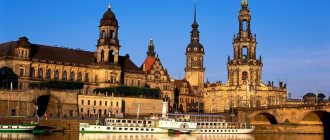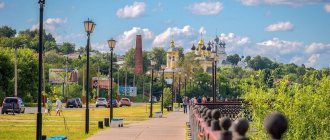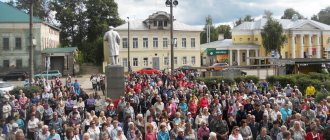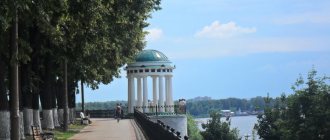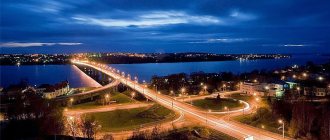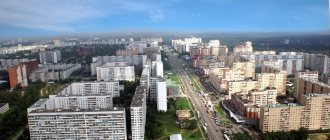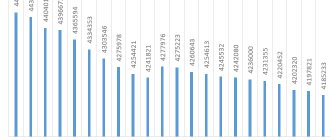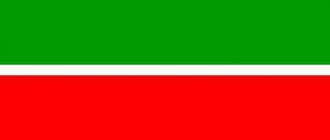The first inhabitants of the Nizhny Novgorod region appeared in the Mesolithic era; evidence of this is kept in museums.
It’s worth visiting this region to see the figure-eight staircase in Nizhny Novgorod, visit the places where Seraphim of Sarov lived and try to see the Russian Atlantis - Kitezh-grad.
Here you can learn how to make nesting dolls and weave lace, carve a figure out of stone and go fishing on Lake Vadsko.
In Nizhny Novgorod there is a piece of Switzerland - this is the name of the park with well-groomed paths, a zoo and fountains.
For ease of route planning, we have marked all mentioned cities and attractions on the map of the region:
Content
- 1 Millionaire cities with more than 1 million people 1.1 Nizhny Novgorod
- 2.1 Dzerzhinsk
- 3.1 Sarov
- 4.1 Navashino
Religious composition
Now let's find out what the population of the Nizhny Novgorod region is like in religious terms.
On the territory of the described subject of the Federation there are quite a few different religious movements. In addition, Nizhny Novgorod is the administrative center of not only the region, but also the Volga Federal District, which, in turn, is the most multi-religious region of the Russian Federation.
The majority of the region's population are Orthodox Christians. Their number currently reaches 76% of all residents of the region. Nizhny Novgorod even has its own metropolis, and the number of parishes in the region reaches 420. In addition, there are fifteen monasteries.
One of the currents of the Orthodox religion is the Old Believers. However, the official church considers this trend sectarian. At the same time, it is the Nizhny Novgorod region that is the cradle of this religious movement. The organizer of his ideology, Archpriest Avvakum, was born here. Therefore, it is natural that it is in this region, in comparison with other subjects of the Federation, that the traditions of the Old Believers remain quite strong. The community of Old Believers is especially large in the Koverninsky district.
Members of other Christian denominations are also present in the region. These are representatives of various Protestant movements: Baptists, Pentecostals, Seventh-day Adventists, Lutherans and other, younger churches. The traditions of Protestantism have been strong in the region since the time of settlement of these places by the Volga Germans. In addition, there is a Catholic parish in Nizhny Novgorod, but it has a rather limited number of parishioners.
There are many Muslims in the Nizhny Novgorod region. There are even more of them than representatives of various Christian movements (naturally, if you do not take into account the Orthodox). This situation is associated with the relatively large number of Tatars and other peoples living in the region, whose national religion is Islam. The Spiritual Administration of Muslims, located in Nizhny Novgorod, is considered the center of Islam in the region.
In addition, there is a Jewish community in the Nizhny Novgorod region. The only synagogue in the region is located in its administrative center - Nizhny Novgorod. At the same time, the total number of Jews in the region is 3.7 thousand people.
There are also residents in the region who profess other religions, but they are not united in communities and do not have official status.
As we can see, the religious diversity in the Nizhny Novgorod region is very diverse.
Millionaire cities with more than 1 million people
Coat of arms of Nizhny Novgorod Flag of Nizhny Novgorod
Nizhny Novgorod
Population 1,266,871 (2016). The largest city on the Volga, the third most populous city in the European part of Russia. In the RSFSR it was the third city in terms of population and industrial potential; its population at its peak reached 1.44 million (1992). After the collapse of the USSR, the city experienced severe depopulation due to the city's proximity to Moscow. The population reached 1 million people in 1962. According to 2011-2013 data, the city ranked 29th to 32nd in the country in terms of industrial production[1].
Among other things, the city is home to the large shipbuilding plant Krasnoye Sormovo, the Nizhny Novgorod Stadium and.
Coat of arms of Dzerzhinsk
Historical sites and museums
Museum and tourist center in Semenov
Address: Semenov, st. Chkalova, 15B Phone: +7 920 252‑72-00, +7 83162 5‑61-41 Website: semenov-museum.ru Opening hours: Mon-Fri 9:00-18:00; Sat 9:00-13:00; Sun 10:00-16:00 Cost: 100-450 rubles
The museum is built in the form of a painted tower. Here are collections of objects painted with Khokhloma - dishes, toys and even furniture.
In the “Royal Room” the walls and a three-meter throne are decorated, and there is a set of carved figures - 240 objects in total.
The complex's employees conduct master classes on making and painting toys.
Vetluzhsky Museum of Local Lore
Address: Vetluga, st. Lenina, 1A Phone: +7 83150 2‑25-60 Website: vmuzeum.nnov.muzkult.ru Opening hours: Mon-Fri 8:00-17:00; Sun 8:00-14:00 Cost: 14-35 rubles
The museum occupies an old merchant's house from the 19th century.
On the ground floor, the natural world of the Vetluzh region is presented - stuffed animals and herbariums. The second floor is dedicated to the history of the region and the city. There are household and art objects from estates and peasant houses, a collection of weapons and cannons from the times of Peter the Great.
You can also see a collection of handwritten and early printed books.
The next room is dedicated to the history of persecution of Orthodox Christians in Soviet times.
Mining Museum in Peshelani
Address: s. Peshelan Phone: +7 83147 5‑52-81 Website: pgz-tour.ru/obekty/1 Opening hours: Mon-Sun 8:00-17:00 Cost: 400 rubles How to get there: from Nizhny Novgorod along the P-158 highway to s. Peshelan 2 hours 5 minutes, 130 km, by bus 1 hour 32 minutes.
The museum is located in a mined mine at a depth of 65 meters. The exhibition includes old stone carts and rock mining tools. In addition, the site of an ancient man was reconstructed here and a psychological camp was equipped.
You can spend time with health benefits in a shungite room - this rock is believed to have healing properties.
At the very bottom there is a so-called panic room with various frightening mannequins.
Lace Museum in Balakhna
Address: Balakhna, st. Karla Marksa, 4 Phone: +7 83144 6‑16-62, +7 83144 6‑28-40 Website: bmihk.ru Opening hours: Mon, Tue, Wed, Thu, Fri, Sun 9:00-17:00 Cost : 100-340 rubles
The main exhibits of the museum are samples of lace from the 19th century.
There are creations for everyday needs: clothes, scarves, bed linen and towels. The collection also contains lace icons from the 17th century and works from the Soviet period.
A design invented by local craftsmen—the “robe rose”—adorned the wedding dress of Queen Victoria of England.
Voznesensky Matryoshka Museum
Address: Voznesenskoye town, st. Sovetskaya, 14 Phone: +7 83178 6‑11-62, +7 83178 6‑11-16 Website: voznmuseum.rfnn.ru Opening hours: Mon-Thu 8:00-17:00; Fri 8:00-16:00; Sat 9:00-13:00 Cost: 30-60 rubles
A tour of the museum begins with the history of toy production; there is even a production model carved out of wood and a real tool from the 18th century.
There is also a prototype of the matryoshka doll - the Chinese toy Futurama. The figures are of different heights, some are almost two meters tall and some are tiny, the smallest is only 5 mm.
In addition, the museum has exhibitions on the following topics: “Russian hut of the 19th century”, “Voznesensky and Izhevsk factories of the Batashev brothers”, “Forties - fatal”, “Factory Polkh-Maidan painting”, “Archaeology”, “Clothing of the 19th-20th centuries "," Lapot-bast."
After the tour you can attend master classes.
Museum of Speed in Chkalovsk
Address: Chkalovsk, st. Chkalova, 4 Phone: 8-(83160)-4-20-51 Website: https://russian wings.rf/musey_skorostey Opening hours: Mon-Sun 9:00-17:00 Cost: 50-200 rubles
The first exhibition of the museum is dedicated to barge haulers, who were hired by shipbuilders here. The following describes the appearance of the first steam ships and ekranoplanes.
Most of the exhibition is dedicated to Rostislav Alekseev, the first person who managed to construct flying ships. In a separate room there are items from his office, first developments and awards.
The museum's collection also contains household items of merchants and peasants from the 18th to 20th centuries.
Semenovsky Historical and Art Museum
Address: Semenov, st. Vaneeva, 5 Phone: +7 83162 5‑19-30, +7 83162 5‑61-4 Website: semenov-museum.ru Opening hours: Mon-Fri 9:00-18:00; Sat 9:00-13:00; Sun 10:00-16:00 Cost: 25-50 rubles
Most of the collection was collected by Georgy Matvey, a woodcarver.
Part of the exhibition represents the life of the Old Believers; there is a model of their monastery. The collections also contain a collection of various spoons and nesting dolls. A separate room is dedicated to the works of writers Boris Kornilov and Sergei Afonin.
Pashkov Estate
Address: s. Vetoshkino How to get there: from Nizhny Novgorod along the M-7 highway to the village. Vetoshkino, 2 hours 47 minutes, 170 km
The estate was built over 40 years, from 1826 to 1866. Previously, there were many premises on the territory: a residential building, an outbuilding, outbuildings and a stud farm.
Now almost everything has been destroyed, but parts of the decoration can still be seen on the ruins of the house, and an exhibition of Gzhel art has been placed in the outbuilding.
Levashov estate in Galibikhe
Address: s. Galibikha How to get there: to Nizhny Novgorod along highway 22B-015 to Galibikha, 2 hours 23 minutes, 160 km, by bus 2 hours 49 minutes.
The estate is a complex of wooden buildings from the early 19th century.
Four houses are closed to the public due to their dilapidation, but the open house contains a small exhibition telling about the owners of the estate.
It is known that Alexander Pushkin visited here, and the complex itself was built according to the design of Andrei Delvig.
Museum-Reserve of A. S. Pushkin “Boldino”
Address: s. Bolshoye Boldino, st. Pushkinskaya, 144 Phone: +7 83138 2‑33-77, +7 83138 2‑29-52 Website: boldinomuzey.ru Opening hours: Tue-Sun 9:00-17:00 Cost: 250 rubles How to get there: from Nizhny Novgorod along the M-7 highway to the village. Bolshoye Boldino, 3 hours 22 minutes, 220 km, 4 hours by bus.
The estate in the village belonged to the Pushkin family for more than 300 years. Here the writer created the last chapters of “Onegin”, “The Miserly Knight”, “Mozart and Salieri”, “A Feast during the Plague”, “Don Juan”, “The Bronze Horseman”, “Angelo”, “The Tale of the Fisherman and the Fish”.
The furnishings inside the estate have been restored as they were during the poet’s lifetime, and all items are original.
The reserve also includes an estate in Lvovka, the Museum of Fairy Tales and the houses of the Uspensky and Fialkovsky priests.
Shukhov Tower on the Oka River
Address: Dzerzhinsk
The building, 128 meters high, is the only one of its kind in Russia. Has the title of cultural heritage of the Nizhny Novgorod region.
You cannot climb to the top of the tower, but the area nearby is landscaped with benches and flower beds.
If you look at it while standing next to it, it creates the illusion of tilting.
Medium-sized cities 20-100 thousand people
Sarov
Population 94,417 people (2016). Closed city.
Bor
Population 78,385 (2017). A satellite city of Nizhny Novgorod, located opposite it across the Volga River.
Kstovo
Population 67,305 people (2016).
Pavlovo
Population 58,423 people (2016).
Vyksa
Population 53,477 people (2016).
Balakhna
Population 49,626 people (2016).
Trans-Volga region
Population 38,906 people (2016).
Bogorodsk
Population 34,597 people (2016).
Kulebaki
Population 33,280 people (2016).
Gorodets
Population 30,530 people (2016).
Semyonov
Population 24,583 (2016).
Lyskovo
Population 21,308 people (2016).
Sergach
Population 20,370 people (2016).
Shakhunya
Population 20,217 people (2016).
Small towns up to 20 thousand people
Navashino
Population 15,281 people (2016).
In the city on the banks of the Navashinsky backwater of the Oka River, among other things, the Okskaya Shipyard is located - a manufacturer of small and medium-sized ships, as well as pontoon parks, which is a city-forming enterprise.
Despite formally belonging to another region, Navashino is actually a satellite town of Murom beyond the Oka.
Lukoyanov
Population 14,243 people (2016).
Pervomaisk
Population 13,706 people (2016).
Uren
Population 12,257 people (2016).
Chkalovsk
Population 11,601 people (2016).
Vorsma
Population 10,630 people (2016).
Volodarsk
Population 10,084 people (2016).
Transportation
Population 9,041 people (2016).
Vetluga
Population 8,470 people (2016).
Knyaginino
Population 7,092 people (2016).
Gorbatov
Population 2,004 people (2016).
National composition
Now let's find out the national composition of the region's inhabitants. The population of the Nizhny Novgorod region is quite ethnically diverse. The nationalities that represent the region are quite diverse. But among them the Russians stand out numerically. Currently, their number in the Nizhny Novgorod region is approximately 3110 thousand people, or 93.9% of the population of the entire region. Thus, this nationality has unconditional dominance in this subject of the Federation. This situation has persisted for hundreds of years. It must be said that for the XX-XXI centuries. the percentage of Russians to all residents of the region never fell below 92%.
Among the national minorities inhabiting the Nizhny Novgorod region, Tatars are in first place. This is due to the proximity of the region to the Republic of Tatarstan. The number of Tatars is about 44 thousand people, or 1.33% of the total population. Tatars in terms of number of residents are followed by Mordovians (0.58%), Ukrainians (0.53%), Armenians (0.4%) and Chuvash (0.29%).
Among the population of the Nizhny Novgorod region there are also such exotic nationalities as Koreans and Yezidis, but their number is quite small and does not exceed several thousand people.
see also
- Nizhny Novgorod Region
- Cities of Russia
| [ + ] Cities by regions of Russia | |
| Cities of the North-West (NWFD) | St. Petersburg (and its cities) • Leningrad region (historical Staraya Ladoga) • Arkhangelsk region • Vologda region • Kaliningrad region • Karelia • Komi • Murmansk region • Nenets Autonomous Okrug • Pskov region |
| Cities of the Volga region (Volga Federal District) | Bashkortostan • Volgograd region • Kalmykia • Kirov region • Mari El • Mordovia • Nizhny Novgorod region • Orenburg region • Penza region • Perm region • Samara region • Saratov region • Tatarstan • Udmurtia • Ulyanovsk region • Chuvashia |
| Cities of Southern Russia (SFD) | Sevastopol (including Inkerman) • Republic of Crimea • Adygea • Astrakhan region • Krasnodar region • Rostov region |
| Cities of the North Caucasus (NCFD) | Dagestan • Ingushetia • Kabardino-Balkaria • Karachay-Cherkessia • North Ossetia - Alania • Stavropol Territory • Chechen Republic |
| Cities of the Urals (Ural Federal District) | Kurgan region • Sverdlovsk region • Tyumen region • Khanty-Mansi Autonomous Okrug - Yugra • Chelyabinsk region • Yamalo-Nenets Autonomous Okrug |
| Cities of Siberia (Siberian Federal District) | Altai Republic • Altai Territory • Irkutsk Region • Kemerovo Region • Krasnoyarsk Region • Novgorod Region • Novosibirsk Region • Omsk Region • Tomsk Region • Tyva • Khakassia |
| Cities of the Far East (FEFD) | Amur Region • Buryatia • Jewish Autonomous Region • Trans-Baikal Territory • Kamchatka Territory • Magadan Region • Primorsky Territory • Sakha (Yakutia) • Sakhalin Region • Khabarovsk Territory • Chukotka Autonomous Region |
| see also | Cities of the DPR, LPR, Transnistria, South Ossetia • Regions of Russia • Cities of Russia |
Population density
Density can be calculated by knowing the number of people in the Nizhny Novgorod region and the area of the territory occupied by them.
The area of the region is 76,624 square meters. km. Thus, by simple calculations it can be established that the average population density of the Nizhny Novgorod region is 42.6 people/sq. km. This is the 23rd result out of 85 regions of the country. If we do not take into account the population density in regions whose main territory is cities, then the Nizhny Novgorod region will be in 20th place. For comparison: in the most populated region of the country (Moscow), the population density is 164.9 people/sq. km, and in the most deserted region (Chukchi Autonomous Okrug) – 0.1 people/sq. km.
So the Nizhny Novgorod region looks good in the all-Russian statistics on population density. The area and population of this region are correlated in such a way that the number of people living here is higher than in a significant part of other subjects of the Federation.


